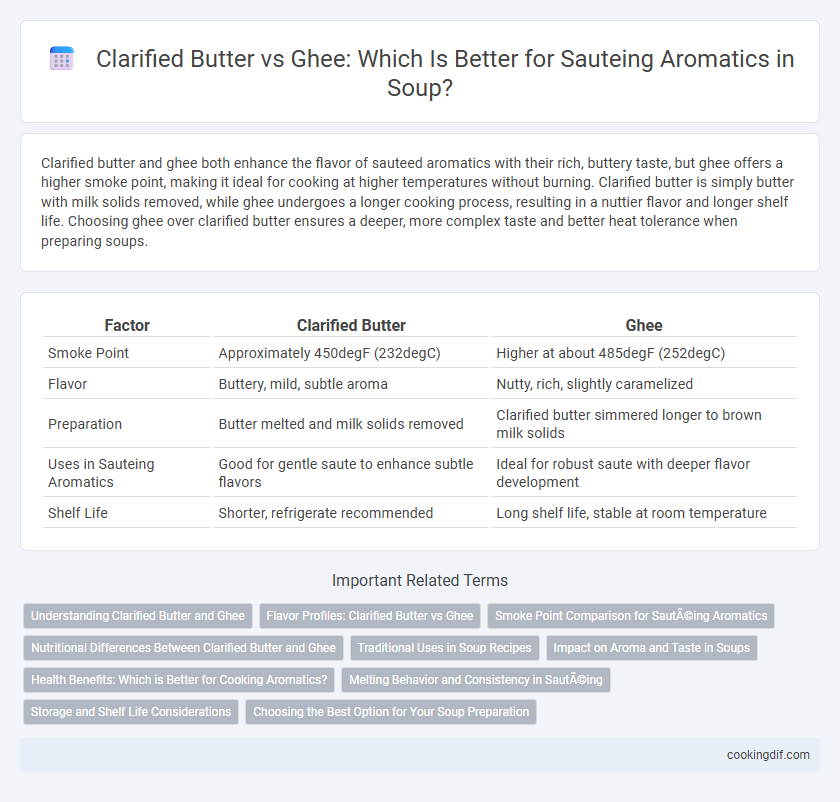Clarified butter and ghee both enhance the flavor of sauteed aromatics with their rich, buttery taste, but ghee offers a higher smoke point, making it ideal for cooking at higher temperatures without burning. Clarified butter is simply butter with milk solids removed, while ghee undergoes a longer cooking process, resulting in a nuttier flavor and longer shelf life. Choosing ghee over clarified butter ensures a deeper, more complex taste and better heat tolerance when preparing soups.
Table of Comparison
| Factor | Clarified Butter | Ghee |
|---|---|---|
| Smoke Point | Approximately 450degF (232degC) | Higher at about 485degF (252degC) |
| Flavor | Buttery, mild, subtle aroma | Nutty, rich, slightly caramelized |
| Preparation | Butter melted and milk solids removed | Clarified butter simmered longer to brown milk solids |
| Uses in Sauteing Aromatics | Good for gentle saute to enhance subtle flavors | Ideal for robust saute with deeper flavor development |
| Shelf Life | Shorter, refrigerate recommended | Long shelf life, stable at room temperature |
Understanding Clarified Butter and Ghee
Clarified butter is butter with milk solids and water removed, resulting in a clear fat ideal for sauteing aromatics at medium heat without burning. Ghee, a form of clarified butter, undergoes a longer cooking process, caramelizing the milk solids before removal and imparting a nuttier flavor with a higher smoke point. Both fats enhance the aromatic base of soups but ghee offers greater heat tolerance and a richer taste profile for intensified flavor development.
Flavor Profiles: Clarified Butter vs Ghee
Clarified butter has a mild, clean flavor with a slightly nutty undertone, enhancing sauteed aromatics with subtle richness without overpowering the dish. Ghee offers a more complex, toasted, and caramelized flavor profile due to its longer cooking process, adding depth and warmth to soups. Both fats have high smoke points suitable for sauteing, but ghee's intensified flavor makes it ideal for robust, spiced soup bases.
Smoke Point Comparison for Sautéing Aromatics
Clarified butter and ghee both offer higher smoke points than regular butter, making them ideal for sauteing aromatics without burning. Clarified butter typically smokes around 450degF (232degC), while ghee has a slightly higher smoke point between 485degF and 500degF (252degC to 260degC), providing greater resistance to heat. This difference allows ghee to maintain flavor integrity and prevent bitterness during high-heat sauteing of onions, garlic, and herbs in soup preparation.
Nutritional Differences Between Clarified Butter and Ghee
Clarified butter and ghee both have high smoke points ideal for sauteing aromatics, but ghee contains slightly higher concentrations of fat-soluble vitamins A, D, E, and K due to its extended cooking process. Clarified butter retains some milk solids, which may affect lactose-sensitive individuals, whereas ghee is more lactose- and casein-free, making it more suitable for those with dairy sensitivities. The slight variations in antioxidant content and fatty acid profiles contribute to ghee's reputation as a healthier choice for cooking, especially in traditional Indian cuisine.
Traditional Uses in Soup Recipes
Clarified butter and ghee both enhance soup bases by providing rich, nutty flavors ideal for sauteing aromatics like onions, garlic, and ginger. Traditional Indian and Middle Eastern soup recipes often use ghee to impart depth and a subtle caramelized taste, while French cuisine favors clarified butter for its clean, high-heat properties that prevent burning. Choosing between clarified butter and ghee depends on the desired flavor profile and cultural authenticity in soup preparation.
Impact on Aroma and Taste in Soups
Clarified butter and ghee both enhance soup aromatics but differ in flavor depth and aroma. Clarified butter offers a clean, buttery aroma that subtly enriches the soup's base, while ghee imparts a nutty, caramelized fragrance that intensifies the overall taste complexity. Choosing ghee elevates the soup's richness, creating a more robust and layered flavor profile compared to the lighter, more neutral notes from clarified butter.
Health Benefits: Which is Better for Cooking Aromatics?
Clarified butter and ghee both offer high smoke points ideal for sauteing aromatics, but ghee contains more antioxidants and butyrate, promoting gut health and reducing inflammation. Clarified butter retains some milk solids, which may cause sensitivities in lactose-intolerant individuals, whereas ghee is fully purified, enhancing digestibility. Choosing ghee for cooking aromatics provides a healthier option with anti-inflammatory benefits and improved nutrient absorption.
Melting Behavior and Consistency in Sautéing
Clarified butter melts quickly and remains transparent, providing an even cooking surface ideal for sauteing aromatics without burning. Ghee, with its longer shelf stability and nutty flavor, offers a slightly thicker consistency that browns slower, enhancing the caramelization of onions, garlic, and spices. The higher smoke point of ghee compared to clarified butter allows for more controlled heat application during the saute process.
Storage and Shelf Life Considerations
Clarified butter and ghee both offer extended shelf lives compared to regular butter due to their reduced milk solids, with ghee typically lasting up to a year when stored in an airtight container in a cool, dark place. Clarified butter, while shelf-stable, usually has a shorter storage duration of about a month in the refrigerator. Proper storage of either fat prevents rancidity and maintains their rich, nutty flavor essential for sauteing aromatics in soups.
Choosing the Best Option for Your Soup Preparation
Clarified butter offers a mild, buttery flavor and a higher smoke point than regular butter, making it ideal for gently sauteing aromatics without burning. Ghee, with its rich, nutty taste and even higher smoke point, enhances the depth of flavor in soups while providing greater heat stability during cooking. Selecting ghee or clarified butter depends on the desired flavor intensity and cooking temperature, ensuring optimal aroma extraction for a perfectly balanced soup.
clarified butter vs ghee for sautéing aromatics Infographic

 cookingdif.com
cookingdif.com